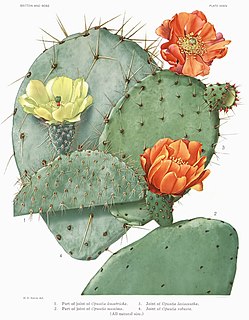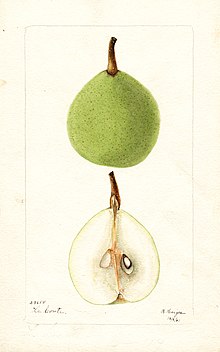
The pear tree and shrub are a species of genus Pyrus, in the family Rosaceae, bearing the pomaceous fruit of the same name. Several species of pear are valued for their edible fruit and juices while others are cultivated as trees.

The avocado, a tree likely originating from south-central Mexico, is classified as a member of the flowering plant family Lauraceae. The fruit of the plant, also called an avocado, is botanically a large berry containing a single large seed.

The quince is the sole member of the genus Cydonia in the family Rosaceae. It is a deciduous tree that bears a pome fruit, similar in appearance to a pear, and bright golden-yellow when mature. Throughout history the cooked fruit has been used as food, but the tree is also grown for its attractive pale pink blossoms and other ornamental qualities.

Theobroma grandiflorum, commonly known as cupuaçu, also spelled cupuassu, cupuazú, cupu assu, or copoasu, is a tropical rainforest tree related to cacao. Common throughout the Amazon basin, it is cultivated in the jungles of Colombia, Bolivia and Peru and in the north of Brazil, with the largest production in Pará. The pulp of the cupuaçu fruit is consumed throughout Central and South America, is the state fruit of Pará, and is used to make ice creams, snack bars, and other products.
Le Conte, LeConte, or Leconte may refer to:

John Lawrence LeConte was an American entomologist of the 19th century, responsible for naming and describing approximately half of the insect taxa known in the United States during his lifetime, including some 5,000 species of beetles. He was recognized as the foremost authority on North American beetles during his lifetime, and has been described as "the father of American beetle study."

Chayote, also known as mirliton squash, is an edible plant belonging to the gourd family, Cucurbitaceae. Chayote was one of the several foods introduced to the Old World during the Columbian Exchange. Also during this period, the plant spread from Mesoamerica to other parts of the Americas, ultimately causing it to be integrated into the cuisine of many other Latin American nations.

Joseph Le Conte was a physician, geologist, professor at the University of California, Berkeley and early California conservationist.

Opuntia ficus-indica is a species of cactus that has long been a domesticated crop plant grown in agricultural economies throughout arid and semiarid parts of the world. Likely having originated in Mexico, O. ficus-indica is the most widespread and most commercially important cactus. Common English names for the plant and its fruit are Indian fig opuntia, Barbary fig, cactus pear, prickly pear, and spineless cactus, among many. In Mexican Spanish, the plant is called nopal, while the fruit is called tuna, names that may be used in American English as culinary terms.

John Eatton Le Conte, Jr. was an American naturalist. He was born near Shrewsbury, New Jersey, the son of John Eatton Le Conte and Jane Sloane Le Conte. He graduated from Columbia College, where he showed an interest in science and was taught natural history by David Hosack, founder of Elgin Botanical Garden.

Halimione portulacoides or sea purslane (2n=36) is a small greyish-green shrub widely distributed in temperate Eurasia and parts of Africa.

Hydrangea arborescens, commonly known as smooth hydrangea, wild hydrangea, or sevenbark, is a species of flowering plant in the family Hydrangeaceae. It is a small- to medium-sized, deciduous shrub up to 3 m (10 ft) tall that is native to the eastern United States.
Crataegus flava, common names summer haw and yellow-fruited thorn, is a species of hawthorn native to the southeastern United States from Virginia to Florida, west to Mississippi. Unfortunately, due to an error by Sargent the name C. flava was, and often still is, used for a different species C. lacrimata, which belongs to a different series, the Lacrimatae series. Flavae is another group of species that were thought to be related to the misidentified C. flava, and although it is now apparent that they are not related, the name of the group remains. Because the true identity of this species has only recently been discovered, the name is rarely used correctly.

The Black Worcester pear is a cultivar of the European pear, it may have come to UK via the Romans, but also has been used in Heraldry and around the city of Worcester. The dark fruit are mainly used for cooking or culinary uses.

Opuntia humifusa, commonly known as the devil's-tongue, Eastern prickly pear or Indian fig, is a cactus of the genus Opuntia present in parts of eastern North America.

Chicago Park is a residential and unincorporated historic agricultural community in Nevada County, California. It is located along Highway 174, with its center at the intersection of Mt. Olive Road. The neighborhood gets its name from its founding residents, who came from Chicago to California in the late 1800s to grow fruit, which was often shipped back to Illinois for consumption. Chicago park is about 9 miles southeast of Grass Valley and about 3 miles north of Colfax.

Satyrium liparops, the striped hairstreak, is a butterfly of the family Lycaenidae described by John Eatton Le Conte in 1833. It is found in North America, from the Rocky Mountains south from southern Canada to Colorado, east to Maine and south to Florida.
Pogonocherus penicillatus is a species of beetle in the family Cerambycidae. It was described by John Eatton Le Conte in Agassizz in 1850. It is known from Canada and the United States.
Mecas marginella is a species of beetle in the family Cerambycidae. It was described by John Eatton Le Conte in 1873. It is known from the United States.
Oberea schaumii is a species of beetle in the family Cerambycidae. It was described by John Eatton Le Conte in 1852. It is known from Canada.

















